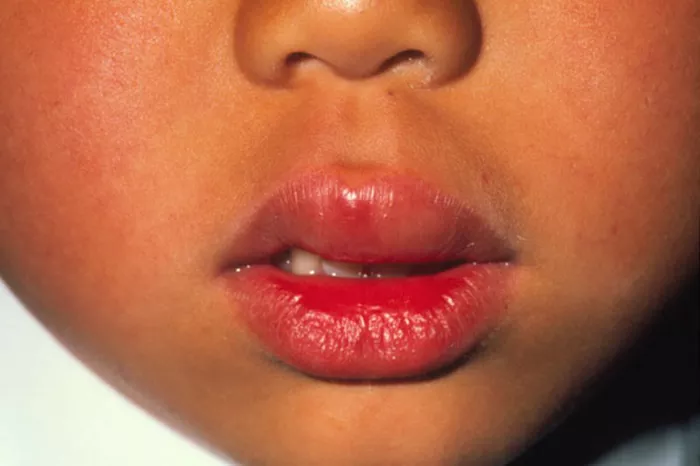Hives, also known as urticaria, are a common skin condition characterized by the sudden appearance of swollen, pale red bumps or plaques (welts) on the skin. When hives appear on the lips, they can cause discomfort, swelling, and sometimes severe reactions that can affect breathing or swallowing. This article explores the multifaceted causes of hives on the lips, alongside effective treatments and preventative measures. By understanding the underlying causes, affected individuals can better manage their condition and minimize occurrences.
What Are Hives?
Before delving into specific triggers and treatments for lip hives, it’s essential to understand what hives are. Hives are the result of the body’s release of histamine, a chemical that your body produces when it detects something harmful, such as an allergen. When histamine is released, it increases the permeability of blood vessels, causing fluid to accumulate in the skin, which leads to the swollen patches associated with hives.
Common Causes of Hives on Lips
The causes of hives on the lips can be categorized into allergic reactions, infections, physical triggers, and other systemic issues. Each category has unique triggers and mechanisms:
Allergic Reactions: A Primary Culprit
Identifying Allergens
Allergens are the most common cause of hives on the lips. These can range from foods and medications to beauty products that come into direct contact with the lips.
Food Allergies: Common food allergens include nuts, eggs, shellfish, and dairy products. When these foods come into contact with the lips, they can trigger an allergic response.
Medication Allergies: Certain medications, like antibiotics or non-steroidal anti-inflammatory drugs (NSAIDs), can cause allergic reactions that manifest as hives on the lips.
Contact Allergens: Lip balms, makeup, and other products containing preservatives and flavoring agents can also be potential allergens that cause hives.
Managing Allergic Reactions
Immediate management of allergic reactions typically involves removing the allergen and administering antihistamines. For severe reactions, such as those accompanying angioedema or anaphylaxis, emergency medical intervention with epinephrine may be necessary.
Infections: Viral and Bacterial Factors
Role of Infections in Causing Hives
Infections, especially those of a viral nature, can lead to hives. For instance, the herpes simplex virus, which causes cold sores, may also cause hives on the lips in some people.
Bacterial Infections: Less commonly, bacteria like streptococci can cause infections around the mouth that trigger hives.
Fungal Infections: While less likely, fungal infections due to candida around the lips can also contribute to hives in susceptible individuals.
Treatment and Management of Infections
Treatment depends on the type of infection and includes antiviral, antibacterial, or antifungal medications. Maintaining good oral hygiene and avoiding known irritants can help prevent such infections.
Physical Triggers: Pressure, Temperature, and More
Understanding Physical Urticaria
Physical urticaria refers to hives caused by direct physical stimulation of the skin such as pressure, heat, cold, or sunlight. Some individuals may experience hives on the lips due to these factors.
Cold-Induced Urticaria: This occurs when the lips are exposed to cold weather or cold water.
Solar Urticaria: Exposure to sunlight can sometimes trigger hives on the lips.
Pressure Urticaria: Actions such as playing certain wind instruments can trigger hives due to pressure.
Preventing and Treating Physical Urticaria
Preventive measures include avoiding known triggers and protecting the lips under extreme weather conditions or during high-risk activities. Treatment might involve the use of antihistamines or topical creams to manage symptoms.
Systemic Causes: Beyond the Skin
Exploring Systemic Conditions
In some cases, hives on the lips may be a manifestation of an underlying systemic condition. This includes autoimmune disorders or even chronic infections.
Autoimmune Disorders: Conditions like lupus or Sjögren’s syndrome can have cutaneous manifestations, including hives.
Chronic Infections: Long-standing internal infections can cause systemic inflammation that manifests externally as hives.
Comprehensive Management of Systemic Causes
Managing these conditions often requires a multidisciplinary approach involving specialists who can address the underlying systemic issue. Treatment may include immunosuppressants or other targeted therapies depending on the condition.
Conclusion: Navigating Lip Hives with Understanding and Care
Hives on the lips can arise from a myriad of causes, each requiring a specific approach for management and treatment. By identifying the underlying cause—be it an allergen, a physical trigger, an infection, or a systemic condition—affected individuals can implement effective strategies to prevent and manage episodes. Regular consultation with healthcare providers, allergen avoidance, and appropriate use of medications remain fundamental in managing this uncomfortable and sometimes distressing condition. With the right knowledge and tools, individuals suffering from hives on the lips can lead a comfortable and symptom-free life.
[inline_related_posts title=”You Might Be Interested In” title_align=”left” style=”list” number=”6″ align=”none” ids=”7695,7692,7713″ by=”categories” orderby=”rand” order=”DESC” hide_thumb=”no” thumb_right=”no” views=”no” date=”yes” grid_columns=”2″ post_type=”” tax=””]

































